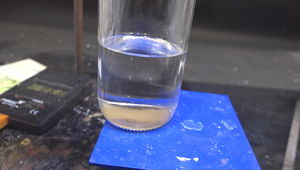Difference between revisions of "Dioxane"
m (Mabus moved page 1,4-Dioxane to Dioxane: Since the other two dioxane isomers are rarely encountered, the 1,4 prefix is not crucial) |
|
(No difference)
| |
Revision as of 21:14, 17 December 2018
 1,4-Dioxane prepared from ethylene glycol antifreeze
| |
| Names | |
|---|---|
| IUPAC names
1,4-Dioxane
1,4-Dioxacyclohexane | |
| Other names
[1,4]Dioxane
[6]-crown-2 p-Dioxane Diethylene dioxide Diethylene ether Dioxan | |
| Properties | |
| C4H8O2 | |
| Molar mass | 88.11 g/mol |
| Appearance | Colorless liquid |
| Odor | Ether-like |
| Density | 1.033 g/mL |
| Melting point | 11.8 °C (53.2 °F; 284.9 K) |
| Boiling point | 101.1 °C (214.0 °F; 374.2 K) |
| Miscible | |
| Solubility | Miscible with most organic solvents |
| Vapor pressure | 29 mmHg (20 °C) |
| Thermochemistry | |
| Std molar
entropy (S |
196.6 J·K−1·mol−1 |
| Std enthalpy of
formation (ΔfH |
-354 kJ/mol |
| Hazards | |
| Safety data sheet | Sigma-Aldrich |
| Flash point | 12 °C (54 °F; 285 K) |
| Lethal dose or concentration (LD, LC): | |
| LD50 (Median dose)
|
5.7 g/kg (mouse, oral) 5.2 g/kg (rat, oral) 3.9 g/kg (guinea pig, oral) 7.6 g/kg (rabbit, dermal) |
| LC50 (Median concentration)
|
10,109 ppm (mouse, 2 hr) 12,568 ppm (rat, 2 hr) |
| Related compounds | |
| Related compounds
|
Ethylene oxide Tetrahydrofuran |
| Except where otherwise noted, data are given for materials in their standard state (at 25 °C [77 °F], 100 kPa). | |
| Infobox references | |
1,4-Dioxane, also known as diethylene ether, diethylene dioxide or simply dioxane, as the 1,2 and 1,3 isomers are rarely encountered, is a heterocyclic organic compound, a cyclic ether.
Contents
Properties
Chemical
Dioxane can be reacted with dry chlorine gas to yield trans-2,3-dichloro-1,4-dioxane.
Dioxane burns with a smokeless yellow-white flame.
Physical
Dioxane is a colorless liquid, with a faint sweet odor similar to that of diethyl ether. It is miscible with many solvents and is hygroscopic. Dioxane boils at 101.1 °C and freezes at 11.8 °C.
Availability
Dioxan can be bought from eBay.
Preparation
Dioxane is produced by the acid-catalysed dehydration of ethylene glycol, using conc. sulfuric acid as catalyst. The reaction takes place under reflux. Commercial anti-freeze can be safely used as EG source, regardless of impurities and additives, though concentrated anti-freeze gives a better yield than the diluted version.
Frogfot wrote a synthesis of dioxane.
Projects
- Stabilize trichloroethane
- Medium for organic reactions
- Purification of metallic sodium from sodium-magnesium oxide aggregate
Handling
Safety
Dioxane is considered carcinogenic. It is also very flammable.
Dioxane is sometimes confused with dioxin.
Storage
Dioxane should be stored in closed bottles, with a reducing agent to prevent the formation of peroxides. Dioxane is safe to keep without anti-oxidants for maximum one year, after which the levels of peroxides become too dangerous to handle.
Disposal
Dioxane can be safely burned, as long as it contains no detectable amounts of peroxides. If the dioxane tests positive for peroxides, but there is no visible precipitate in the ether, it's possible to neutralize the dissolved peroxides. Reducing agents, like ferrous sulfate, sodium bisulfite or metabisulfite added in excess can be used to neutralize the peroxides. After neutralization, the ether should be tested again for peroxides and if none are present, it can be safely burned.
If it's an old bottle, which has visible peroxide in the solution, or if very old, is very likely to have peroxides on the cap, DO NOT OPEN THE BOTTLE! Instead take it to a remote of special area and safely detonate it. The latter may or may not require professional help, depending on the severity of the case.